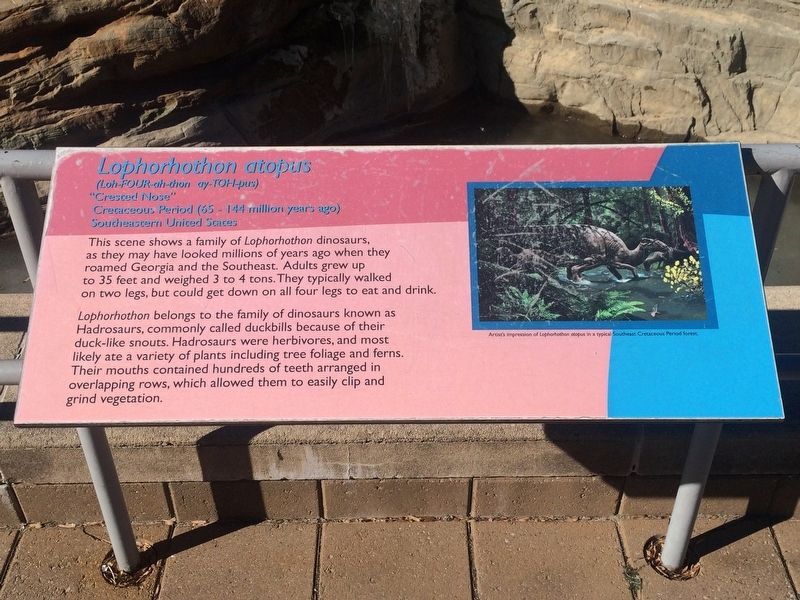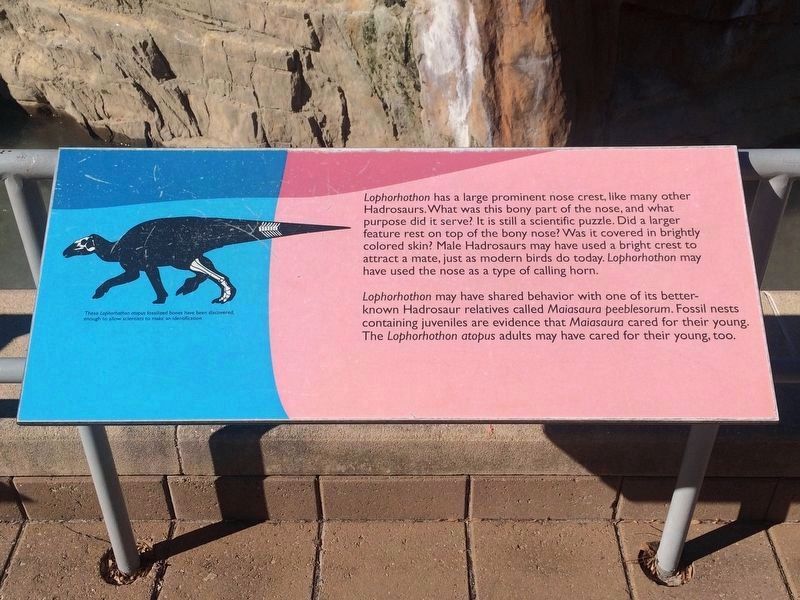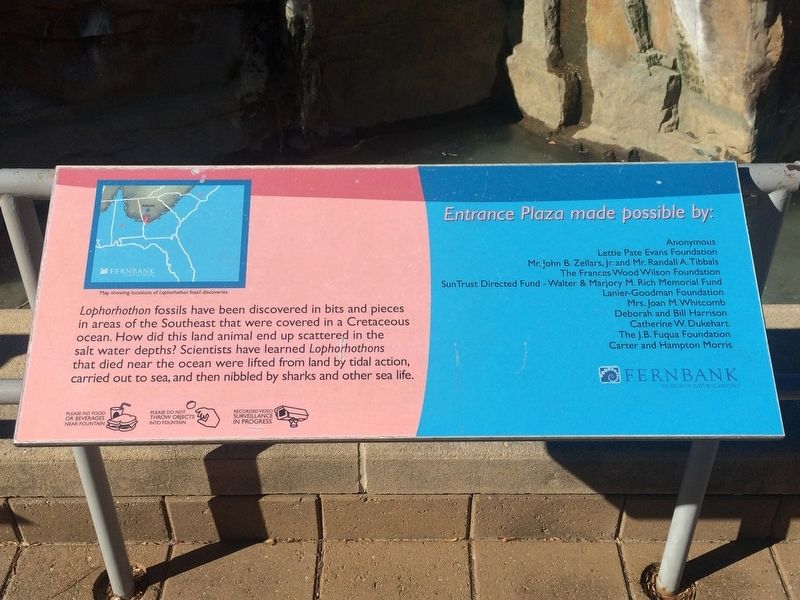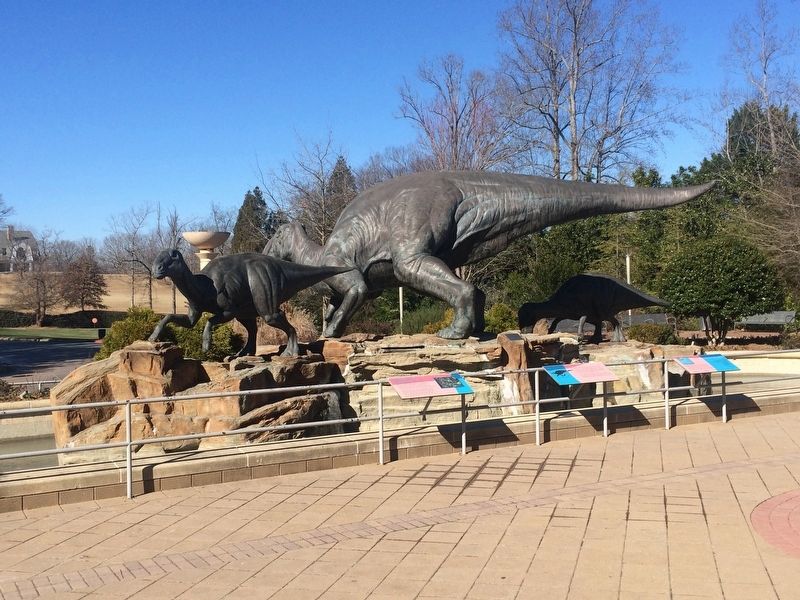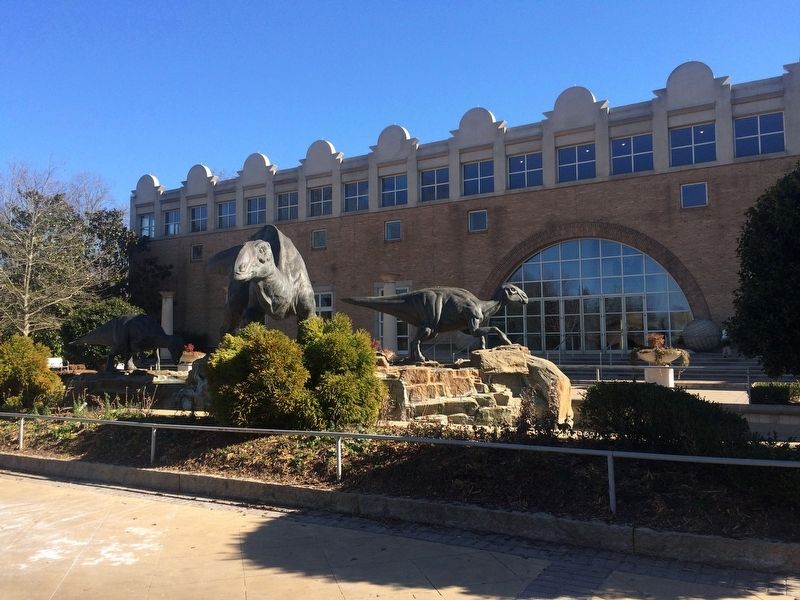Druid Hills in Atlanta in DeKalb County, Georgia — The American South (South Atlantic)
Lophorhothon atopus
“Crested Nose”
Inscription.
Lophorhothon atopus
(Loh-FOUR-ah-thon ay-TOH-pus)
“Crested Nose”
Cretaceous Period (65- 144 million years ago)
Southeastern United States
This scene shows a family of Lophorhothon dinosaurs, as they may have looked millions of years ago when they roamed Georgia and the Southeast. Adults grew up to 35 feet and weighed 3 to 4 tons. They typically walked on two legs, but could get down on all four legs to eat and drink.
Lophorhothon belongs to the family of dinosaurs known as Hadrosaurs, commonly called duckbills because of their duck-like snouts. Hadrosaurs were herbivores, and most likely ate a variety of plants including tree foliage and ferns. Their mouths contained hundreds of teeth arranged in overlapping rows, which allowed them to easily clip and grind vegetation.
Caption: Artist's impression of Lophorhothon atopus in a typical Southeast Cretaceous Period forest.
Lophorhothon has a large prominent nose crest, like many other Hadrosaurs. What was this bony part of the nose, and what purpose did it serve? It is still a scientific puzzle. Did a larger feature rest on top of the bony nose? Was it covered in brightly colored skin? Male Hadrosaurs may have used a bright crest to attract a mate, just as modern birds do today. Lophorhothon may have used the nose as a type of calling horn.
Lophorhothon may have shared behavior with one of its better known Hadrosaur relatives called Maiasaura peeblesorum. Fossil nests containing juveniles are evidence that Maiasaura cared for their young. The Lophorhothon atopus adults may have cared for their young, too.
Caption: These Lophorhothon atopus fossilized bones have been discovered, enough to allow scientists to make an identification.
Lophorhothon fossils have been discovered in bits and pieces in areas of the Southeast that were covered in a Cretaceous ocean. How did this land animal end up scattered in the salt water depths? Scientists have learned Lophorhothons that died near the ocean were lifted from land by tidal action, carried out to sea, and then nibbled by sharks and other sea life.
Caption: Map showing locations of Lophorhothon fossil discoveries.
Entrance Plaza made possible by:
Anonymous
Lettie Pate Evans Foundation
Mr. John B. Zellars, Jr. and Mr. Randall A.Tibbals
The Frances Wood Wilson Foundation
Sun Trust Directed Fund - Walter & Marjory M. Rich Memorial Fund
Lanier-Goodman Foundation
Mrs. Joan M. Whitcomb
Deborah and Bill Harrison
Catherine W. Dukehart
The J.B.
Fuqua Foundation
Carter and Hampton Morris
Fernbank Museum of Natural History
Erected by Fernbank Museum of Natural History.
Topics. This historical marker is listed in these topic lists: Animals • Paleontology • Science & Medicine.
Location. 33° 46.457′ N, 84° 19.691′ W. Marker is in Atlanta, Georgia, in DeKalb County. It is in Druid Hills. Marker can be reached from Clifton Road, on the right when traveling east. The markers are directly in front of the entrance to the Fernbank Natural History Museum. Touch for map. Marker is at or near this postal address: 767 Clifton Road, Atlanta GA 30307, United States of America. Touch for directions.
Other nearby markers. At least 8 other markers are within 2 miles of this marker, measured as the crow flies. Georgia Railway and Power Company Trolley Waiting Station (approx. 0.4 miles away); Lynching in America / The Lynching of Porter Turner (approx. 0.8 miles away); Alpha Delta Pi (approx. 0.8 miles away); Sweeny's Division Encamped (approx. 0.9 miles away); Site: Judge James Paden House: Gen. J.D. Cox’s H’dq’rs (approx. 1.1 miles away); Noon Under the Trees (approx. 1.1 miles away); Old Williams Mill Rd. (approx. 1.2 miles away); The March to the Sea (approx. 1.2 miles away). Touch for a list and map of all markers in Atlanta.
Credits. This page was last revised on February 8, 2023. It was originally submitted on February 2, 2018, by J. Makali Bruton of Accra, Ghana. This page has been viewed 443 times since then and 30 times this year. Photos: 1, 2, 3, 4, 5. submitted on February 2, 2018, by J. Makali Bruton of Accra, Ghana.
